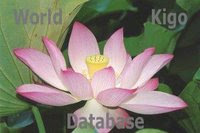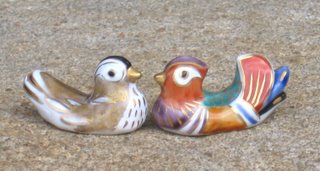:::::::::::::::::::::::::::::::::::::::::::::::::::::::::::::::::::::::::::::::::::::::::::::::::::::
Tsurukame ― Crane, Tortoise and Daruma
鶴亀とだるま
The Beard of Daruma was painted in the form of a snake (rather "Dragon"「蛇=龍」) in the beginning. Why did it change to a tortoise?
The beard is a snake 「蛇」
The beard is a turtiose 「亀」
 This image dates from 1777 and shows a Tumbler Doll Daruma with Saigyoo Hooshi (a famous poet, Saigyo Hoshi 西行法師). This is probably the oldest picture of a Daruma Doll. From then on Daruma became a popular theme.
This image dates from 1777 and shows a Tumbler Doll Daruma with Saigyoo Hooshi (a famous poet, Saigyo Hoshi 西行法師). This is probably the oldest picture of a Daruma Doll. From then on Daruma became a popular theme. This illustration shows the face of this Daruma. His eyebrows are in the form of a crane and the beard clearly shows the form of a snake, or rather a wild dragon.
This illustration shows the face of this Daruma. His eyebrows are in the form of a crane and the beard clearly shows the form of a snake, or rather a wild dragon. This is a modern classical Daruma Doll and as we can see the beard looks like a tortoise lifting its head."The crane lives 1000 years, the tortoise 10.000 years" as a Japanese proverb goes. Both animals are symbols of longevity.
This is a modern classical Daruma Doll and as we can see the beard looks like a tortoise lifting its head."The crane lives 1000 years, the tortoise 10.000 years" as a Japanese proverb goes. Both animals are symbols of longevity.But why was it a snake in the beginning?
And for what purpose did it change into a turtoise? And what about the combination with a crane? Maybe the tortoise is the painted version of the deformation of the snake's head and the scales?
:::::::::::::::::::::::::::::::::::::::::::::::::::::::::::::::::::::::::::::::::::::::::::::::::::::
Tortoise and Snake 亀と蛇
I have checked out about the connection of Turtoise-Snake first and the story brings us back to ancient China.
In Chinese culture, especially under the influence of Taoism (道教) the turtoise is the symbol of heaven and earth, its shell compared to the vaulted heaven and the underside to the flat disc of the earth. The tortoise was the hero of many ancient legends. It helped the First Chinese Emperor to tame the Yellow River, so Shang-di rewarded the animal with a lifespan of Ten Thousand Years. Thus the turtoise became a symbol for Long Life.
It also stands for immutability and steadfastness. We often see stone grave steles on a stone tortoise or reliquiaries standing on it.
The tortoise is also regarded as an immortal creature. As there are no male tortoise - as the ancient believed - the female had to mate with a snake. Thus the turtoise embracing a snake became the protector symbol of the north, but since the word "tortoise" was taboo in Chinese, it was referred to as the "dark warrior" (genbu 玄武 ) and finally became one of the protector gods of the four areas, Zhenwu in Chinese Taoism.
 This sone sculpture is part of a sarcophage of a Chinese aristocrat around 500, showing a turtoise entwined by a snake. The symbol of Zhenwu, the Protector God of the North, as tortoise and snake dates back to the third century B.C.
This sone sculpture is part of a sarcophage of a Chinese aristocrat around 500, showing a turtoise entwined by a snake. The symbol of Zhenwu, the Protector God of the North, as tortoise and snake dates back to the third century B.C. This one (which is a little hard to see) we have an ink rubbing from a stele from the Pagoda of Six Harmonies in Zhejiang province, China, from about 1586. Here we see Zhenwu, the Perfected Warrior, standing on the back of a tortoise entwined with a snake.
This one (which is a little hard to see) we have an ink rubbing from a stele from the Pagoda of Six Harmonies in Zhejiang province, China, from about 1586. Here we see Zhenwu, the Perfected Warrior, standing on the back of a tortoise entwined with a snake.  The two animals themselves where also used to represent the protector gods of the north. This tradition was carried over to Japan, where for example Tokugawa Ieyasu was very concious in choosing a place for his new capital, Edo, with a Mountain (Mt. Fuji) and the Dark Warrior in the north.
The two animals themselves where also used to represent the protector gods of the north. This tradition was carried over to Japan, where for example Tokugawa Ieyasu was very concious in choosing a place for his new capital, Edo, with a Mountain (Mt. Fuji) and the Dark Warrior in the north.. The four protector deities of Edo
During the birthday celebrations for a Chinese emperor, a crane and a turotise had to come forth and dance for him, praying for his long life. Then the emperor himself would perform a dance praying that his reign and life be long, his country be in peace and prosperous.
You can find out more about Taoism and Zhenwu in the magnificent catalog about "Taoism and the Arts of China".
http://www.asianart.com/exhibitions/taoism/
:::::::::::::::::::::::::::::::::::::::::::::::::::::::::::::::::::::::::::::::::::::::::::::::::::::
Tsurukame tsuru kame 鶴亀 Tortoise and Crane
The connection between a turtoise and a crane also dates back to China. The crane too was a symbol of Long Life and also the symbol of the relationship of Father and Son according to the Confucian philosophy. Furthermore the crane is a symbol of wisdom. When a highranking Taoist priest died, it was said he was "turning into a crane".
In Japanese Buddhist art, we have a candle holder in the form of a crane standing on a tortoise (tsurukame shokudai 鶴亀燭台). This kind of temple decoration was often used by the New Sect of the Pure Land (joodo shinshuu 浄土真宗). Usually the crane was carrying a lotos flower with a long stem in his mouth and the flower was formed in a way to hold the candle. These types of illumination stands were produced since the Muromachi Period.
Tsuruame candleholder 鶴亀の燭台
. . . CLICK here for Photos !
At the famous Tooshoogu Shrine in Nikko, there is a huge monument in the form of Crane/Tortoise.
日光東照宮の鶴亀の燭台。
http://sat.cside3.jp/home/1/tra27-1-4.html

There is a store that sells Tsurukame zabuton covers.
座布団にも鶴亀。
. . . CLICK here for Photos !
In the tradition of Kaga Yuuzen, there is also a door curtain (noren) with this decoration as a wedding present for a bride.
“Hanayome Noren”(花嫁のれん)is said to be the origin of " Kaga Yuzen" a sheet of cloth on which felicitous designs such as "Shoochikubai"(pine leaves, bamboo and plum flowers) or "Tsurukame"(crane and tortoise) are hand dyed and used as one of the bridal items.
http://www.kimono.or.jp/dic/eng/03Dye-Hokuriku.html
Finally a classic Noh-Play with this conspicious title.
能舞台にも鶴亀があります。
. . . CLICK here for Photos !
:::::::::::::::::::::::::::::::::::::::::::::::::::::::::::::::::::::::::::::::::::::::::::::::::::::
The famous Daruma from Shirawaka features more good luck symbols: The Pine/Bamboo/Plum with Crane/Tortoise. (Shoochikubai Tsurukame). The tradition goes back to Matsudaira Sadanobu (1758 -1829).
松平定信公のおかかえ画匠・谷文晁の考案によると伝えられる「鶴亀松竹梅」を取り入れた縁起だるま。
. Shirakawa Daruma 白川だるま
:::::::::::::::::::::::::::::::::::::::::::::::::::::::::::::::::::::::::::::::::::::::::::::::::::::
We still do not know when and why the snake changed to a tortoise on the face of Daruma, but we keep looking. But the roots of these animals as symbols for good luck and longevity go way back to ancient China and the Taoist tradition.
Finally just one more stone Daruma in my garden,
with Crane and Tortoise as his facial features in my collection.

鶴亀のだるまの顔や春うるら
tsurukame no Daruma no kao ya haru urara
crane and tortoise
on the face of Daruma san -
a fine spring day
:::::::::::::::::::::::::::::::::::::::::::::::::::::::::::::::::::::::::::::::::::::::::::::::::::
Crane, Grus japonensis (tsuru) as KIGO
Turtle, turtoise (kame) as KIGO
. WHO is Daruma ?
:::::::::::::::::::::::::::::::::::::::::::::::::::::::::::::::::::::::::::::::::::::::::::::::::::::
亀どののいくつのとしぞ不二の山
kame dono no ikutsu no toshi zo fuji no yama
and how old are you
Mr. Turtle?
Mount Fuji
Kobayashi Issa
Tr. David Lanoue
:::::::::::::::::::::::::::::::::::::::::::::::::::::::::::::::::::::::::::::::::::::::::::::::::::::
. Turtle folk toys .
the Urashima Taro Legend 浦島太郎
. Tsuru and Kame - kites from Izumo Shrine .
Legends and Folk Toys from Tottori
:::::::::::::::::::::::::::::::::::::::::::::::::::::::::::::::::::::::::::::::::::::::::::::::::::::
kifu きふ (龟趺)
The [baxia 霸下 . guifu (龟趺)], big tortoises which like to carry heavy objects, are placed under grave-monuments.
hiiki 贔屓
The [bixi 贔屭], which have the shape of the chilong 螭龍, and are fond of literature, are represented on the sides of grave-monuments.
. hiiki 贔屓 / 贔負(ひいき) child of the dragon king .
[ . BACK to DARUMA MUSEUM TOP . ]
[ . BACK to WORLDKIGO . TOP . ]
:::::::::::::::::::::::::::::::::::::::::::::::::::::::::::::::::::::::::::::::::::::::::::::::::::::













